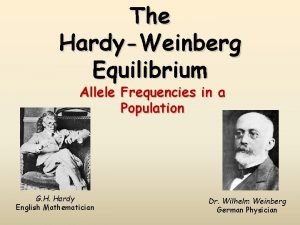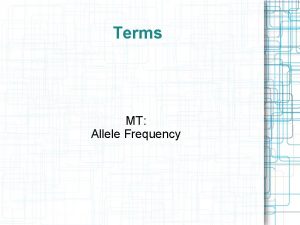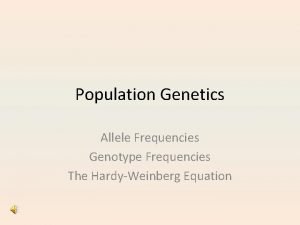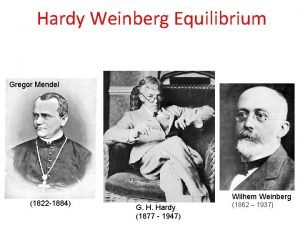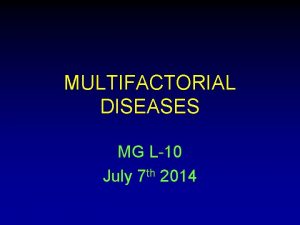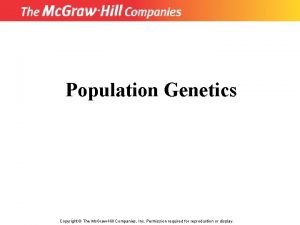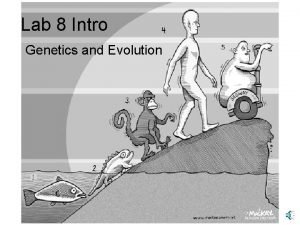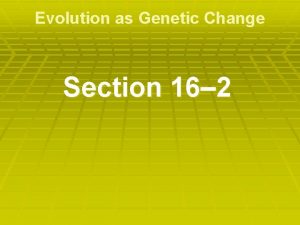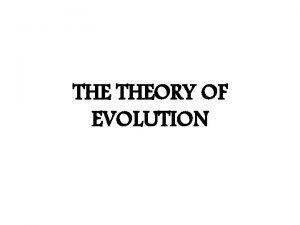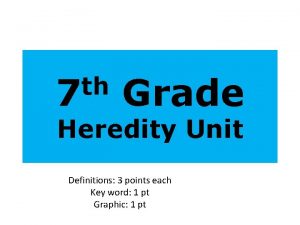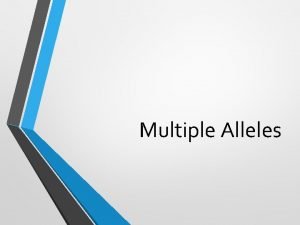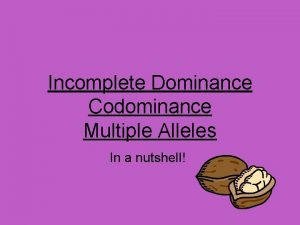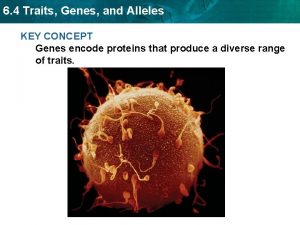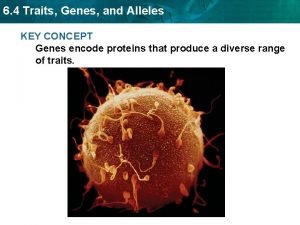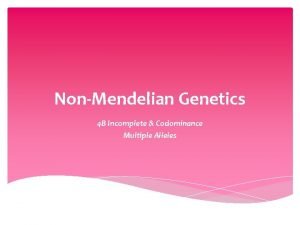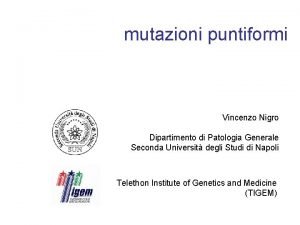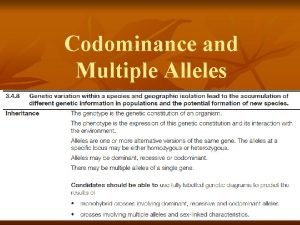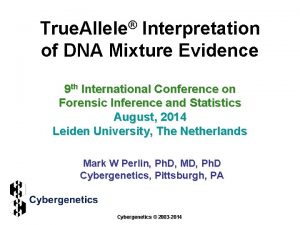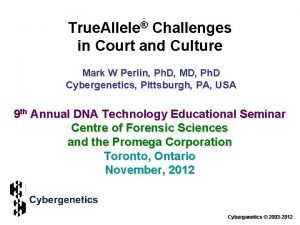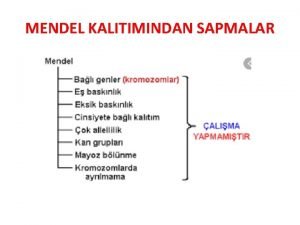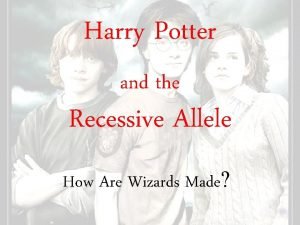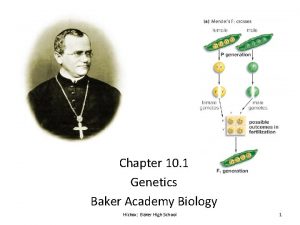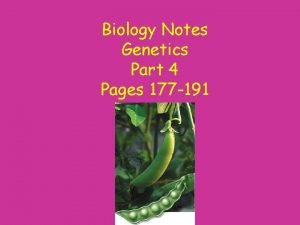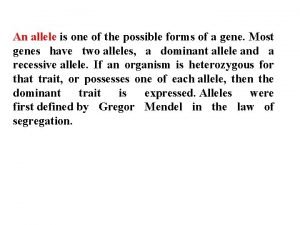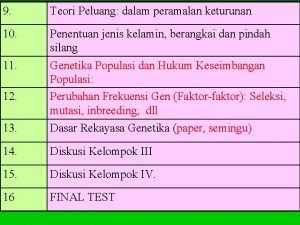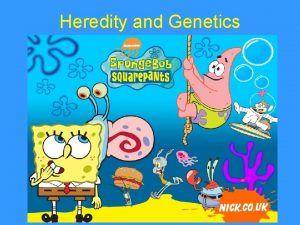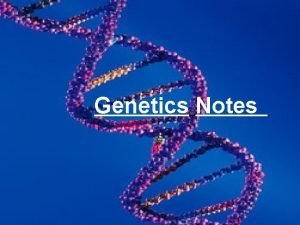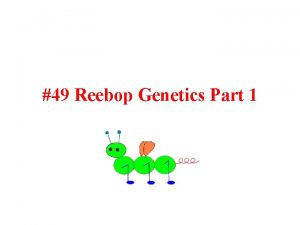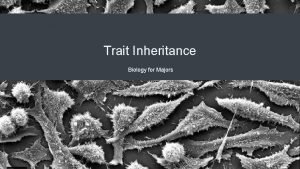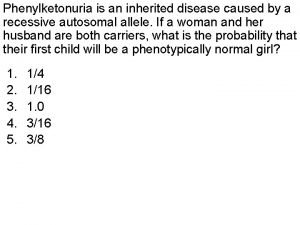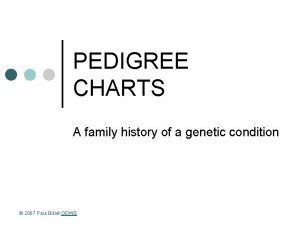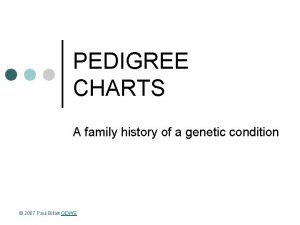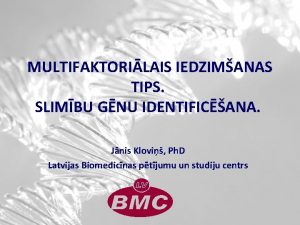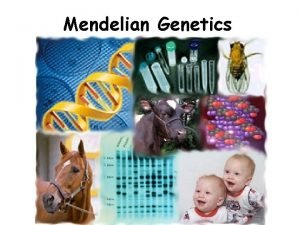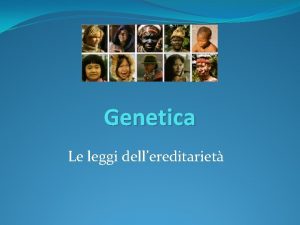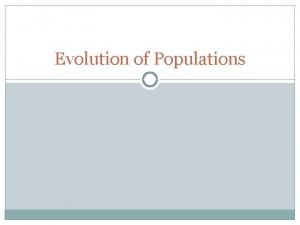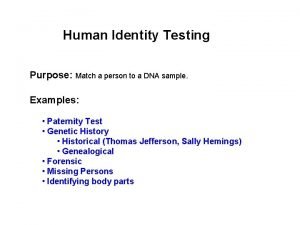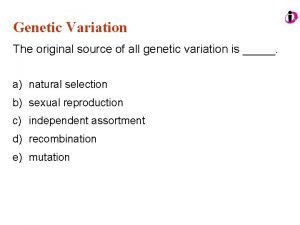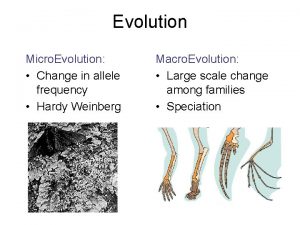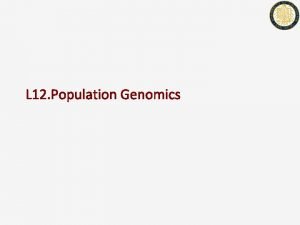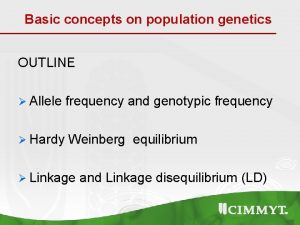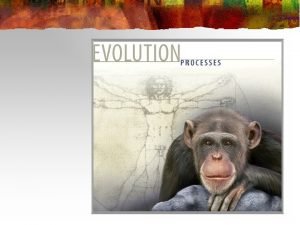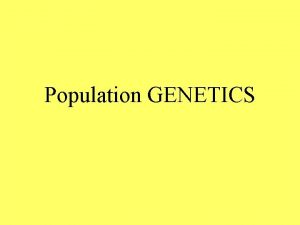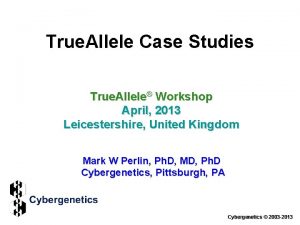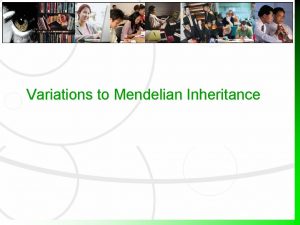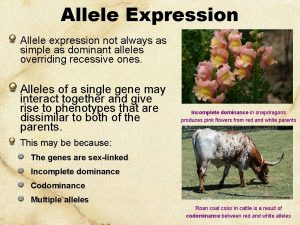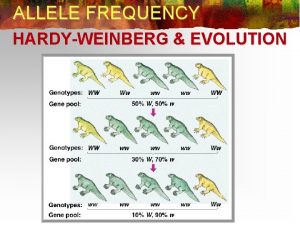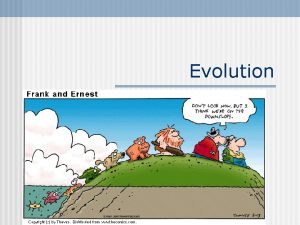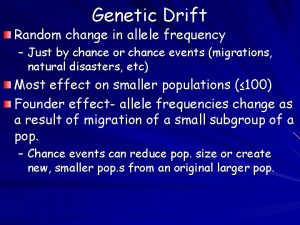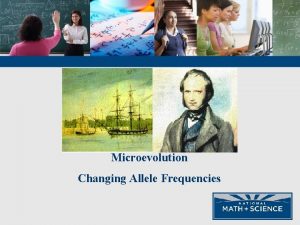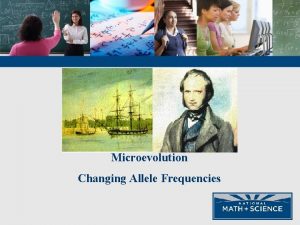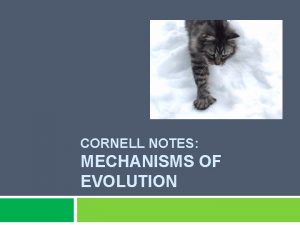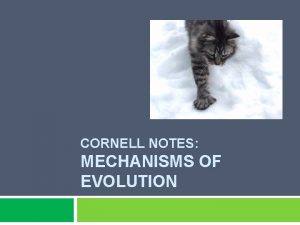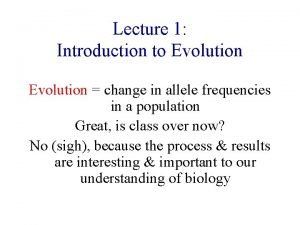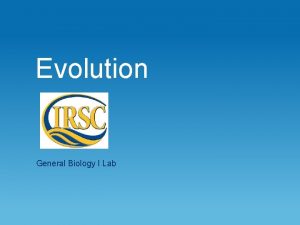Evolution Change in allele frequency in a population


























































- Slides: 58

Evolution Change in allele frequency in a population over time.

Population • A localized group of individuals of the same species.

Importance of Hardy-Weinberg • Way to calculate allele frequencies through time. • Yardstick to measure rates of evolution.

Hardy-Weinberg Assumptions 1. Large Population 2. Isolation 3. No Net Mutations 4. Random Mating 5. No Natural Selection

If H-W assumptions hold true: • The allele frequencies will not change over time. • Evolution will not occur.

Causes of Evolution 1. Genetic Drift 2. Gene Flow 3. Mutations 4. Nonrandom Mating 5. Natural Selection

Genetic Drift • Changes in the gene pool a population due to random chance • Types: 1. Plain Genetic Drift 2. Bottleneck Effect 3. Founder's Effect

By Chance

Bottleneck Effect • Loss of most of the population by disasters. • Surviving population may have a different gene pool than the original population.


Result • Some alleles lost. • Other alleles are over-represented. • Genetic variation usually lost.

Importance • Reduction of population size may reduce gene pool for evolution to work with. • Ex: Cheetahs

Founder's Effect • The reduced genetic diversity that results when a population is descended from a small number of colonizing ancestors. • Ex: Old-Order Amish


Result • Genetic variation reduced. • Some alleles increase in frequency while others are lost (as compared to the parent population). Genetic Drift has a larger impact on small populations

Gene Flow • Movement of genes in/out of a population. • Ex: • Immigration • Emigration

Result • Changes in gene frequencies within a population. • Immigration often brings new alleles into populations increasing genetic diversity.

Mutations • May change allele frequencies (small population). • Source of new alleles for selection. • Often lost by genetic drift.

Nonrandom Mating • Sexual-Selection

Natural Selection • Differential success in survival and reproduction.

Fitness - Darwinian • The relative contribution an individual makes to the gene pool of the next generation.

Chapter 24 The Origin of Species

Question? • What is a species? • Comment - Evolution theory must also explain how species originate.

Question? • How many species of African Violets are here?

Two Concepts of Species 1. Morphological 2. Biological

Morpological Species Concept • Organisms with very similar morphology (physical form) are the same species

Problem • Where does extensive phenotype variation fit?

Biological Species Concept • A group of organisms that could interbreed in nature and produce fertile offspring.

Problems • Can’t apply BSC to: • Asexual organisms • Extinct species

Speciation (new species arising) Requires: 1. Variation in the population. 2. Selection/Genetic Drift 3. Reproductive Isolation. Speciation in lizards https: //www. youtube. com/watch? v=a DIQFQOCGa. I

Reproductive Barriers • Serve to isolate a populations from other gene pools. • Create and maintain “species”.

Main Types of Barriers Prezygotic - Prevent mating or fertilization. Postzygotic - Prevent viable, fertile offspring.

Prezygotic - Types 1. Habitat Isolation 2. Temporal Isolation 3. Behavioral Isolation 4. Mechanical Isolation 5. Gametic Isolation

Habitat Isolation • Populations live in different parts of the environment • Ex – mountains vs lowlands.

Temporal Isolation • Breeding seasons or time of day different. • Ex – flowers open in morning or evening.

Behavioral Isolation • Mating or courtship behaviors different. • Different sexual attractions operating. • Ex – songs and dances in birds.

Mechanical Isolation • Structural differences that prevent gamete transfer. • Ex – anthers not positioned to put pollen on a bee, but will put pollen on a bird.

Gametic Isolation • Gametes fail to attract each other and fuse. • Ex – chemical markers on egg and sperm fail to match.

Postzygotic Types 1. Reduced Hybrid Viability 2. Reduced Hybrid Fertility

Reduced Hybrid Viability • Zygote fails to develop or mature. • Ex – when different species of frogs or salamanders hybridize.

Reduced Hybrid Fertility • Hybrids are viable, but can't reproduce sexually. • Chromosome count often “odd” so meiosis won’t work. • Ex – donkeys and horses produce mules


How do species occur? 1. Allopatric Speciation 2. Sympatric Speciation Both work through a block of gene flow between two populations.


Allopatric Speciation • Allopatric = other homeland • Ancestral population split by a geographical feature.

Sympatric Speciation • Sympatric = same homeland • New species arise within the range of parent populations.


What is the Speed of Speciation?

• Gradualism • Punctuated Equilibrium

Gradualism Predicts: • Long periods of time are needed for steady, continuous evolution • Should see plenty of “transition species” • Problem: not many “transition species” fossils found

Punctuated Equilibrium • Evolution has two speeds of change: • Gradualism or slow change • Rapid bursts of speciation



Predictions • Speciation can occur over short periods of time in a changing environment (natural disasters) • Fossils of transition species are rare



Summary • Be able to discuss the main theories of what is a “species”. • Know various reproductive barriers and examples.

Summary • Know allopatric and sympatric speciation. • Know adaptive radiation. • Be able to discuss gradualism and punctuated equilibrium theories.
 Hardy-weinberg equilibrium
Hardy-weinberg equilibrium Allele frequency def
Allele frequency def What is gene frequency in genetics
What is gene frequency in genetics Calculate allele frequency
Calculate allele frequency How to determine hardy weinberg equilibrium
How to determine hardy weinberg equilibrium How to calculate allele frequency from genotype
How to calculate allele frequency from genotype Allele frequency
Allele frequency Similar
Similar What is joint relative frequency
What is joint relative frequency Frequency vs relative frequency
Frequency vs relative frequency Form factor formula
Form factor formula Vmax=aw
Vmax=aw Frequency vs relative frequency
Frequency vs relative frequency What is a marginal frequency
What is a marginal frequency Joint relative frequency distribution
Joint relative frequency distribution Chapter 4 population ecology section 1 population dynamics
Chapter 4 population ecology section 1 population dynamics Section 1 population dynamics
Section 1 population dynamics Population ecology section 1 population dynamics
Population ecology section 1 population dynamics Chapter 4 section 1 population dynamics
Chapter 4 section 1 population dynamics Section 16–2 evolution as genetic change
Section 16–2 evolution as genetic change Industry evolution and strategic change
Industry evolution and strategic change Slow evolution
Slow evolution Th
Th Allele vs gene
Allele vs gene Blood type codominance
Blood type codominance Sickle cell incomplete dominance
Sickle cell incomplete dominance Codominant allele
Codominant allele Allele example
Allele example Allele vs gene
Allele vs gene Allele vs trait
Allele vs trait Incomplete vs codominance
Incomplete vs codominance Allele antimorfo
Allele antimorfo Allele picture example
Allele picture example Allele
Allele Codominant genes
Codominant genes True allele
True allele True allele
True allele Heterozomi
Heterozomi Harry poter parents
Harry poter parents Eye color punnett square
Eye color punnett square Dominant allele definition
Dominant allele definition Dominant allele definition
Dominant allele definition Dna komplemen
Dna komplemen Allele
Allele Allele
Allele Allele neomorfo
Allele neomorfo Allele
Allele Incomplete penetrance
Incomplete penetrance Pku hereditary
Pku hereditary Pedigree chart
Pedigree chart Pedigree key
Pedigree key Chromosome allele
Chromosome allele Odds ratio
Odds ratio Punnett square color blindness
Punnett square color blindness Incomplete dominance occurs when
Incomplete dominance occurs when Cromosomi omologhi
Cromosomi omologhi Allele frequencies
Allele frequencies Human identity testing
Human identity testing The original source of all genetic variation is _____
The original source of all genetic variation is _____
